
This is part of our series of articles on selecting board games by age. For a full overview of how to pick the best game for your kid(s) check out our full guide.
By two years old, babies have slowly turned to toddlers, and whilst the night feedings may be a lot more infrequent, this stage of a child’s development brings its own set of challenges. A two-year-olds’s speech and cognitive skills have improved greatly but there’s still a long way to go before they’re fully functioning and less dependent on mum and dad.
Board games are a great way to start to introduce concepts to them that will help them to grow and flourish over the next couple of years, as well as refine their motor skills and recognition of colors and shapes.
You might ask if two-year-olds can actually play board games and the answer is yes…but the ideal game should meet certain criteria. The more colorful a game the better. Bright colors will catch their attention initially, and as long as the game is simple to understand and has a relatively short playtime it will keep them captivated and want to come back for more another day.
The bigger the pieces the better as children this young are still prone to putting things in their mouths. A game that sneaks in some learning isn’t a bad thing – like a simple matching game, or a focus on memory skills – and there should be less emphasis on competition and more on cooperative games.
The most important thing is to let your child experiment, investigate and play around with the pieces and the game board when you first play the game as they are always learning and want to get into absolutely everything!
Board Games For 2 Year Olds
Below are a handful of the best board games for 2 year olds. These are games that little kids love and are great to introduce to your little one, and any of them would be great as the very first games you play with your child..
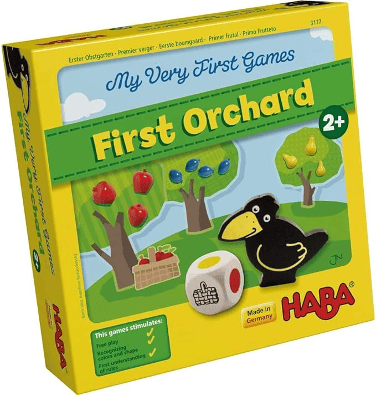
My First Orchard
By: Haba Players: 1-4 players Time: 10 minutes
Time for the fruit to be picked from the orchard! Pick all the apples, plums, and pears you can before the pesky raven arrives!
In this cooperative game, children try and pick different kinds of fruit from their trees before the raven reaches the end of the path. Game set-up is easy: take the four tree cards and place the corresponding pieces of fruit on them. Next, take the five path cards and line them up with the gate at the end, and place the raven figure on the first path card.
Players will then take it in turns to roll the dice, which will result in one of three things happening. If a player rolls a color – red, yellow, green, or blue, they then take a piece of fruit that matches that color and place it in the basket.
If all fruits of the corresponding color have already been picked then nothing happens. If a fruit basket is rolled, one piece of fruit from any tree may be taken and placed in the basket. If the raven is rolled then it progresses one step forward along the path.
The game is won by harvesting every last piece of fruit and placing it in the basket before the raven can get to them. If however, the hungry raven manages to make it up the path and through the gate into the orchard before all the fruits are picked, the players lose.
My First Orchard comes with colorful wooden pieces and large realistic-looking fruits that the kids can place into a large 3-D basket. Haba is famous for their high quality components that kids love and this simple game does not disappoint.
It encourages teamwork and supporting each other as everyone wins or loses together. It’s great for helping little ones improve their motor skills, and is a great way to introduce them to color-matching concepts. It’s a simple game with a short short playtime, that encourages to match colors, make (light) decisions, and practice taking turns. It remains one of the best board games to introduce a toddler to.
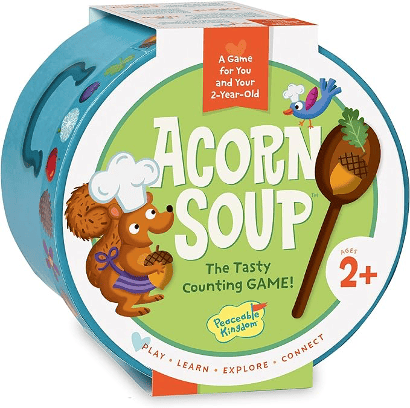
Acorn Soup
By: Peaceable Kingdoms Players: 1-4 Time: 10 minutes
Help the squirrel use their leftover food to create yummy soups with all kinds of different ingredients by following along with the different recipe cards.
In Acorn Soup, players are given different recipe cards and need to add the right ingredients to a pot to create delicious soups. The game comes with plenty of colorful components: two dozen different wooden ingredients representing fruits, nuts, and seeds, eight recipe cards, and a wooden spoon. The game’s storage tub doubles up as the pot where the ingredients need to be placed and at the start of the game, the ingredients and spoon are set next to it.
When ready, a recipe card is chosen, which lists each ingredient and how many are needed. Players will then use the spoon to transport each ingredient into the pot one by one. Once everything is ready, players stir the pot and the soup is ready!
Acorn Soup is a fun game that helps young kids develop their fine motor skills by transporting the ingredients with the spoon to the pot to create each recipe. To create the soups, children will also have to match up the right ingredients and refine their shape and image recognition, and counting skills.
Aside from helping with development in these areas, there is an emphasis on fun and the game plays down the concept of winners and losers, which takes away any stress or tension in playing a board game.
We earn a commission if you make a
purchase, at no additional cost to you.
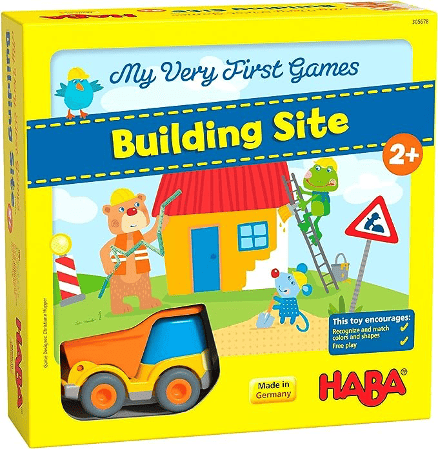
Building Site
By: Haba Players: 1-4 Time: 10 minutes
Perfect for toddlers considering a career in construction. Help construct a house turn by turn and bring the right pieces to the construction site with the aid of the handy dump truck.
Building Site is a cooperative card-flipping memory game. Players work together to match symbols in order to gradually erect a house on a construction site.
At the start of the game, the dump truck is placed on the construction site and the four storage areas are placed around it, along with blocks on their marked areas. There is a construction plan track that shows the progress of the house’s development and the wooden site manager, Bruno Bear, is placed on the first space.
Players then take it in turns to drive the dump truck to the traffic cone tiles and flip them over. If the symbol on the other side matches the one Bruno is standing by, the player puts it in the dump truck, drives it back to the site manager, and places it on the matching symbol. If it doesn’t match then play moves on to the next player.
When both symbols for a construction phase have been found, the truck collects the associated block and places it at the construction site. Once enough tiles have been found, a house and garden will be built on the construction site and the game is over.
Building Site is a great game that helps with developing a child’s memory and their ability to work together with others. The game comes with many colorful and interactive pieces to keep children entertained, including a toy dump truck that kids love. Because what toddler doesn’t enjoy playing with trucks?
We earn a commission if you make a
purchase, at no additional cost to you.
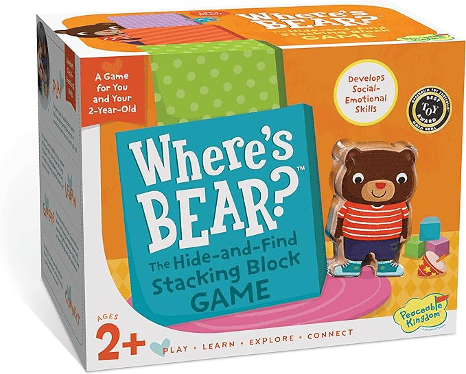
Where’s Bear?
By: Peaceable Kingdom Players: 1-4 Time: 5 minutes
Where’s Bear? combines stacking blocks and finding hidden objects into a game. Try your best to find the bear as he hides inside one of the six sturdy blocks.
Where’s Bear? is a game that takes the emphasis off of winning and losing and instead encourages parents to have their children explore the blocks. Each one is lightweight and sturdy and is decorated in different ways to represent different rooms of the bears house. There are lots of ways to play with the blocks which means this should keep kids busy for a while.
The basic way to play for younger children is to hide the wooden bear toy under a block and ask the child to try and find it. They can be placed side by side or stacked in a nesting doll style and the child can look under each block to find them, helping enhance their gross motor skills. The alternative way to play for more of a challenge is to find the objects listed on the box.
On the top of each box are a handful of objects that are somewhere on one of the boxes’ sides. Kids can then look and try and find the objects in each of the bear’s rooms. Where’s Bear? is super simple in principle but there are plenty of variations to how parents can use the boxes and bear when playing with their children.
Despite such a simple concept, Where’s Bear? aids a child’s development in a number of ways. It introduces object permanence and problem-solving and promotes social skills through in-game interactions. Young children will have plenty of fun exploring and playing with the colorful boxes beautifully illustrated to represent different rooms in the Bear’s house.
We earn a commission if you make a
purchase, at no additional cost to you.
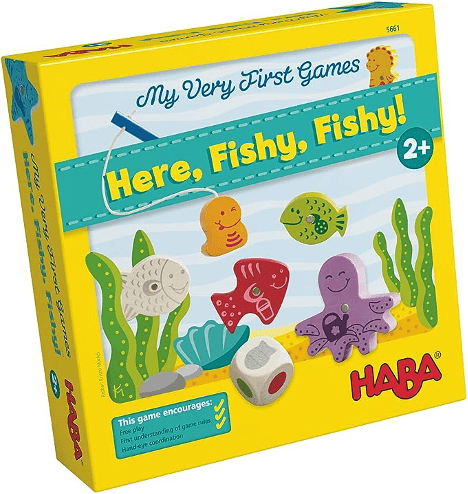
Here, Fishy, Fishy
By: Haba Players: 1-4 Time: 5-10 minutes
Skill and dexterity come into this fishing game as players use the magnetic fishing rod to try and fish up six different sea creatures and complete their puzzle board.
In this fun fishing game, players will try their best to hook multiple different sea creatures with their magnetic fishing rod. The game comes with six different sea dwellers, all chunky and wooden with a small magnet on them.
At the start of the game, these are placed inside the game box which is decorated to resemble the seafloor. Each player has a puzzle-like board with five different objects you might find at the beach (bucket, shovel, etc.) and the object of the game is to complete the puzzle.
With each turn, players roll the dice, each side of which has a different color. They then use the fishing rod to try and catch the animal that corresponds with the color they just rolled.
When they successfully catch it, they then place the item, which also corresponds with the dice and animal, into their board. The player to complete their board first is the winner. There is a glittery fish and side of the dice which, when rolled, means players can choose any of their items to add to the board. For more of a challenge, for adults or kids, they can try closing their eyes when it’s their turn to fish.
A great interactive game that kids love, Here, Fishy, Fishy is excellent in helping toddlers develop hand-eye coordination and their fine motor skills. There are plenty of colorful pieces to captivate their attention and several ways to play to keep them entertained.
We earn a commission if you make a
purchase, at no additional cost to you.
Other Board Game Recommendations
If you need any further recommendations on games for your little one, both Haba and Peaceable Kingdom games series are especially good at creating simple, accessible, and fun games for children as young as 2 years old. Once they’ve mastered these, be sure to check out recommendation for 3, 4 , and 5 year olds, and beyond.
Some other games that deserve an honorable mention are:
Roll & Play (By Think fun)
Roll the large plush dice and follow the instructions. Great for helping children match words and pictures.
Seek-a-Boo (By Mindware)
A fun game that helps improve a child’s vocabulary and memory and introduce them to the concept of matching games.
Shopping List (by Orchard Toys)
Contract fulfillment and memory game requiring kids to collect requested food. Kids will love finding the right foods to fill their carts.
Farm adventure (By Science4you)
A Puzzle and Memory game about Farm Animals.
Also Read: The 10 Best Math Board Games For Kids
Conclusion: Why Wait? Start Playing Games With Your Kids Now!
Playing board games with your children is not only a fun and enjoyable activity, but it also has numerous benefits for their development. From improving memory and problem-solving skills to promoting social interaction and hand-eye coordination, these games are a great way to engage and entertain young minds.
With our list of recommended games, you can easily find the perfect game for your child’s age and interests. So why wait? Start playing and bonding with your little ones now! Whether you choose Where’s Bear?, Here, Fishy, Fishy or any of our other choices for the best board games for 2 year olds, we guarantee your next family game night will be a blast.

